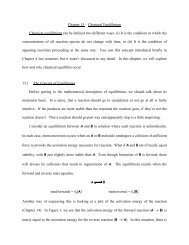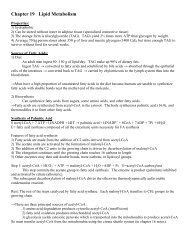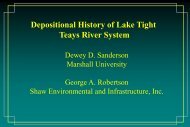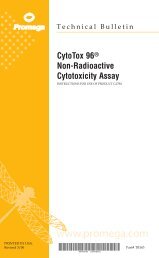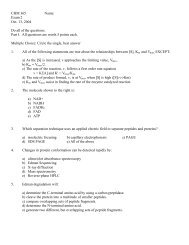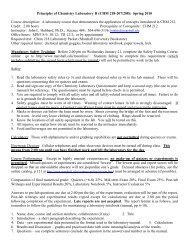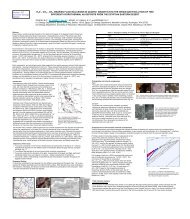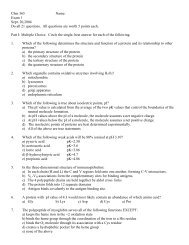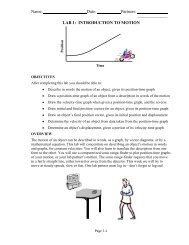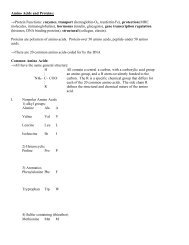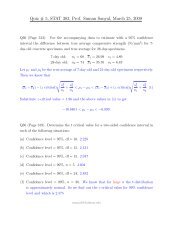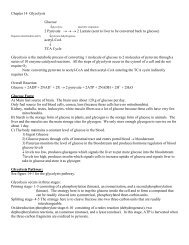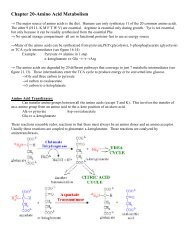Link to our lab as a pdf - College of Science - Marshall University
Link to our lab as a pdf - College of Science - Marshall University
Link to our lab as a pdf - College of Science - Marshall University
Create successful ePaper yourself
Turn your PDF publications into a flip-book with our unique Google optimized e-Paper software.
An Identity Crisis<br />
A Lab on DNA Typing<br />
The Mystery <strong>of</strong> Lyle and Louise 1<br />
rev. 3/4/2008
The Mystery <strong>of</strong> Lyle and Louise:<br />
Identity Crisis:<br />
A Lab on DNA Analysis<br />
National <strong>Science</strong> Education Standards:<br />
Unifying concepts and processes<br />
<strong>Science</strong> <strong>as</strong> inquiry<br />
Life science<br />
Systems, order, and organization<br />
Evidence, models, and explanation<br />
Change, constancy, and me<strong>as</strong>urement<br />
Abilities necessary <strong>to</strong> do scientific inquiry<br />
Understanding about scientific inquiry<br />
The Cell<br />
Molecular b<strong>as</strong>is <strong>of</strong> heredity<br />
<strong>Science</strong> and technology Understanding about science and technology<br />
<strong>Science</strong> in personal and<br />
social perspectives<br />
<strong>Science</strong> and technology in local, national, and global<br />
challenges<br />
His<strong>to</strong>ry and nature <strong>of</strong> science<br />
<strong>Science</strong> <strong>as</strong> a human endeavor<br />
Nature <strong>of</strong> scientific knowledge<br />
Visit Us at:<br />
www.LyleAndLouise.com<br />
Cover and Interior Art by Phil Morrissey<br />
“Forensic DNA Technology” and “PCR Technology” by Jan Sikorsky, PhD, and Julie Sikorsky, MS<br />
Edited by M. Joseph Hughes, MS<br />
Special thanks goes <strong>to</strong> the Integrated <strong>Science</strong> and Technology Department at <strong>Marshall</strong> <strong>University</strong> for their help in developing this suite.<br />
Copyright © 2006-2008 Vandalia Research, Inc.<br />
All Rights Reserved.<br />
www.vandaliaresearch.com<br />
2<br />
The Mystery <strong>of</strong> Lyle and Louise
Table <strong>of</strong> Contents<br />
Introduction <strong>to</strong> Identity Crisis. . . . . . . . . . . . . . . . . . . . . . . . . . 5<br />
Teacher’s Notes. . . . . . . . . . . . . . . . . . . . . . . . . . . . . . . . . . . 7<br />
Teaching Timeline . . . . . . . . . . . . . . . . . . . . . . . . . . . . . . . . . 8<br />
Solutions. . . . . . . . . . . . . . . . . . . . . . . . . . . . . . . . . . . . . . . 9<br />
Glossary . . . . . . . . . . . . . . . . . . . . . . . . . . . . . . . . . . . . . . .12<br />
Forensic DNA Technology . . . . . . . . . . . . . . . . . . . . . . . . . . . .13<br />
PCR Technology . . . . . . . . . . . . . . . . . . . . . . . . . . . . . . . .14<br />
The Investigation . . . . . . . . . . . . . . . . . . . . . . . . . . . . . . . . .19<br />
The Evidence . . . . . . . . . . . . . . . . . . . . . . . . . . . . . . . . . . . .22<br />
The People Involved. . . . . . . . . . . . . . . . . . . . . . . . . . . . . . . 23<br />
Pre-Lab Questions . . . . . . . . . . . . . . . . . . . . . . . . . . . . . . . . 25<br />
Lab Procedure . . . . . . . . . . . . . . . . . . . . . . . . . . . . . . . . . . .27<br />
Data Collection and Calculations . . . . . . . . . . . . . . . . . . . . . . .29<br />
Post-Lab Questions . . . . . . . . . . . . . . . . . . . . . . . . . . . . . . . .30<br />
Mock Trial . . . . . . . . . . . . . . . . . . . . . . . . . . . . . . . . . . . . . .31<br />
The Mystery <strong>of</strong> Lyle and Louise 3
4<br />
The Mystery <strong>of</strong> Lyle and Louise
Introduction <strong>to</strong> Identity Crisis<br />
WELCOME <strong>to</strong> Identity Crisis, a DNA Typing <strong>lab</strong> in the Mystery <strong>of</strong> Lyle and<br />
Louise. A brutal murder c<strong>as</strong>e is unfolding in a small Appalachian <strong>to</strong>wn.<br />
Already the c<strong>as</strong>e spans two crime scenes and five people are dead. However,<br />
two women, one at each crime scene, have been identified <strong>as</strong> Louise Mondelo.<br />
Y<strong>our</strong> students, <strong>as</strong> the forensic<br />
investiga<strong>to</strong>rs responsible for<br />
the DNA evidence, must positively<br />
identify Louise Mondelo<br />
and also analyze the DNA<br />
evidence for clues that might<br />
help crack the c<strong>as</strong>e.<br />
In this <strong>lab</strong>, students will learn<br />
about DNA Typing and related<br />
technologies. These include<br />
the polymer<strong>as</strong>e chain<br />
reaction (PCR), a method for<br />
amplifying small samples <strong>of</strong><br />
DNA, and electrophoresis, a<br />
method for separating bands<br />
within the PCR product. An<br />
introduction <strong>to</strong> short tandem<br />
repeat DNA analysis is also<br />
covered in this booklet.<br />
In addition <strong>to</strong> reading information provided about the c<strong>as</strong>e, students will test<br />
DNA samples from people and objects, compare them <strong>to</strong> each other, and make<br />
<strong>as</strong>sessments <strong>of</strong> the probability that samples came from the same s<strong>our</strong>ce. Once<br />
the <strong>lab</strong> results have been analyzed, students may host a mock trial <strong>to</strong> hold a chosen<br />
suspect accountable for their actions.<br />
Teacher’s notes can be found at the beginning <strong>of</strong> the manual and copies may be<br />
freely made <strong>of</strong> all materials for y<strong>our</strong> students.<br />
The Mystery <strong>of</strong> Lyle and Louise 5
6<br />
The Mystery <strong>of</strong> Lyle and Louise
These notes are provided <strong>to</strong> <strong>as</strong>sist in the preparation<br />
and execution <strong>of</strong> the <strong>lab</strong>ora<strong>to</strong>ry experiment.<br />
A solutions key for the pre- and post-<strong>lab</strong><br />
questions can be found on the reverse.<br />
Supplies<br />
First, inven<strong>to</strong>ry the supplies included in the <strong>lab</strong> kit.<br />
Supplies have been provided for up <strong>to</strong> six groups <strong>of</strong><br />
students.<br />
• DNA for Known Gels (3 sets)<br />
• DNA for Evidence Gels (3 sets)<br />
• Agarose Gels (6 bottles)<br />
• 20x BlueVis Buffer (2 bottles)<br />
• BlueVis Gel Stain (1 bottle)<br />
• InstaStain Sheets (6 sheets)<br />
Refrigerate the entire contents <strong>of</strong> the kit until ready<br />
<strong>to</strong> use.<br />
Other Supplies and Equipment Required<br />
• Lab gloves<br />
• Distilled water<br />
• 1 <strong>to</strong> 4 L capacity bottle<br />
• Microwave<br />
• 5 mL Pipettes and pipet<strong>to</strong>r<br />
• Gel apparatus (6) and power supply<br />
• 10 μL Pipet<strong>to</strong>r and Pipette tips<br />
• OPTIONAL: Staining trays<br />
Running Buffer Preparation<br />
The 20x BlueVis Buffer running buffer must be diluted<br />
<strong>to</strong> 1x before being used in the <strong>lab</strong>. Each 200<br />
mL bottle <strong>of</strong> buffer will make 4 L <strong>of</strong> the solution<br />
used in this <strong>lab</strong>.<br />
Shake the Blue Vis Buffer well before use. To make<br />
1 L <strong>of</strong> 1x BlueVis Buffer add 50 mL <strong>of</strong> the 20x s<strong>to</strong>ck<br />
solution <strong>to</strong> a 1 L capacity bottle, and bring the <strong>to</strong>tal<br />
volume up <strong>to</strong> 1 L with distilled water.<br />
Safety Precautions<br />
1.<br />
2.<br />
3.<br />
4.<br />
5.<br />
Teacher’s Notes<br />
Molten agarose can scald and it must be handled<br />
with care<br />
Serious or lethal electrical shock can result if<br />
the gel apparatus is used improperly.<br />
Remove caps from bottles placed in the microwave<br />
<strong>to</strong> avoid explosion and serious injury.<br />
BlueVis buffer and Gel Stain will stain skin and<br />
clothing; wear gloves while handling.<br />
Review MSDS’s found on the Mystery <strong>of</strong> Lyle<br />
and Louise website.<br />
http://www.lyleandlouise.com/msds<br />
Pipetting Practice<br />
Inexperienced students should practice pipetting<br />
before performing this <strong>lab</strong>. One suggestion is <strong>to</strong> use<br />
a small piece <strong>of</strong> waxed paper and practice picking<br />
up and delivering small volumes <strong>of</strong> colored water.<br />
Students should hold the pipet<strong>to</strong>r <strong>as</strong> vertical <strong>as</strong><br />
possible. Without precise pipetting, experimental<br />
results may not be accurate.<br />
Notes for the Gel<br />
The kit includes enough samples for 3 groups <strong>to</strong><br />
analyze known suspects and victims (Gel A) and another<br />
3 groups <strong>to</strong> analyze the unknowns and evidence<br />
(Gel B). DNA <strong>lab</strong>els are color-coded <strong>to</strong> keep<br />
them separate in the <strong>lab</strong>; DNA that should be run on<br />
Gel A are in blue, DNA for Gel B are in red. Ladder<br />
DNA, which must be run on both gels, h<strong>as</strong> a white<br />
cap.<br />
The BlueVis Gel Stain is the same solution <strong>as</strong> the<br />
20x BlueVis TBE running buffer, but is bottled separately<br />
<strong>to</strong> prevent confusion. If more <strong>of</strong> the stain is<br />
needed, remaining 20X BlueVis Buffer can be used<br />
with no problem. Gels thicker than 1 cm have poor<br />
contr<strong>as</strong>t. Use less than the 80 mL <strong>of</strong> agarose provided<br />
if you have small gel boxes. Note: BlueVis will<br />
not stain DNA if it is overheated. Don’t remelt agarose<br />
after adding BlueVis.<br />
The Mystery <strong>of</strong> Lyle and Louise 7
Teaching Timeline<br />
Groundwork<br />
Before performing any <strong>of</strong> the <strong>lab</strong> exercises in the Lyle and Louise suite, cover the investigation and<br />
background s<strong>to</strong>ry <strong>to</strong> give students a framework for the work they are about <strong>to</strong> do. This only needs <strong>to</strong> be<br />
covered once for all <strong>of</strong> the modules.<br />
Day 1: Cover material in the Forensic DNA Technology Background<br />
Explain how DNA is collected at crime scenes, why DNA amplification is necessary, and how PCR amplification<br />
works. If you have long cl<strong>as</strong>s periods (over an h<strong>our</strong>) save explaining how DNA migrates for the<br />
portion <strong>of</strong> the <strong>lab</strong> when students are watching the DNA migrate in the gel.<br />
Days 2-4: Lab Procedure<br />
The DNA Typing kit is a flexible kit, with several s<strong>to</strong>pping points for teachers who have short cl<strong>as</strong>s periods<br />
or slow gel electrophoresis apparatus. The following instructions will <strong>as</strong>sist you in determining how<br />
<strong>to</strong> organize this kit for y<strong>our</strong> cl<strong>as</strong>s.<br />
Melting and C<strong>as</strong>ting Gels - This can be done in the early part <strong>of</strong> the cl<strong>as</strong>s period, and for cl<strong>as</strong>ses that<br />
are long enough, you can start <strong>to</strong> run the gels. Otherwise, s<strong>to</strong>re the gels in a ziploc bag overnight in the<br />
refrigera<strong>to</strong>r.<br />
Running the Gel - Start by adding the BlueVis running buffer <strong>to</strong> the electrophoresis chamber. This<br />
should be done when you plan <strong>to</strong> start running the gel - don’t let the gel set overnight in the buffer. For<br />
cl<strong>as</strong>ses with slower electrophoresis boxes (where the gel will take longer than the cl<strong>as</strong>s period <strong>to</strong> run),<br />
we have included optional InstaStain sheets <strong>to</strong> resolve the DNA so that the gel can be s<strong>to</strong>red overnight.<br />
Analyzing the Gel in Real-time - While the gel is running, and for several h<strong>our</strong>s after it h<strong>as</strong> run, you can<br />
view the bands with the BlueVis dye present. The BlueVis dye will fade away eventually, and cannot be<br />
s<strong>to</strong>red overnight.<br />
Analyzing the Gel with InstaStain - If you need <strong>to</strong> s<strong>to</strong>re the gel overnight, or wish <strong>to</strong> resolve the bands<br />
more for pho<strong>to</strong>documentation purposes, you can restain the gel with the included InstaStain sheets.<br />
Follow the procedure below:<br />
1. Place the gel in a shallow pl<strong>as</strong>tic container. Fill the container with distilled water.<br />
2. Float the InstaStain sheet, blue side down, on the water.<br />
3. Allow the gel <strong>to</strong> stain and destain overnight.<br />
8<br />
The Mystery <strong>of</strong> Lyle and Louise
Glossary<br />
Agarose: A molecule purified from seaweed that is<br />
used for the electrophoretic separation <strong>of</strong> nucleic<br />
acids.<br />
Allele: One <strong>of</strong> two or more alternative forms <strong>of</strong> a<br />
gene that exist at a specific gene location on a chromosome.<br />
B<strong>as</strong>e: A letter in the DNA alphabet, either adenine<br />
(A), thymine (T), guanine (G), or cy<strong>to</strong>sine (C).<br />
Band: A discrete length <strong>of</strong> DNA that is visualized on<br />
a gel when the DNA in the gel is stained.<br />
Buffer: A solution made <strong>of</strong> acids and their conjugate<br />
b<strong>as</strong>es that is used <strong>to</strong> maintain the pH <strong>of</strong> a system.<br />
Chromosome: A linear strand <strong>of</strong> DNA and proteins<br />
in the nucleus <strong>of</strong> a cell. Chromosomes carry genes<br />
and function in the transmission <strong>of</strong> hereditary information.<br />
Chromosomes are in pairs, one set coming<br />
from each parent.<br />
Comb: A pl<strong>as</strong>tic piece shaped like a comb that leaves<br />
wells in agarose gels.<br />
DNA: Deoxyribonucleic acid (DNA) is a doublestranded,<br />
helical nucleic acid molecule that is the<br />
carrier <strong>of</strong> genetic information.<br />
Gene: A discrete unit <strong>of</strong> hereditary information<br />
that is located on the chromosomes and consists <strong>of</strong><br />
DNA. Genes can have many alleles.<br />
Heterozygous: Having two different alleles for a<br />
given trait, one from each parent.<br />
Homozygous: Having the same allele twice for a<br />
given trait.<br />
Load: Placing the DNA sample in the well <strong>of</strong> the<br />
agarose gel with the pipet.<br />
PCR: The Polymer<strong>as</strong>e Chain Reaction, a technique<br />
used <strong>to</strong> amplify regions within small amounts <strong>of</strong><br />
DNA by copying those regions many times.<br />
Pipette: A device used <strong>to</strong> pick up and deliver a precisely<br />
me<strong>as</strong>ured amount <strong>of</strong> liquid.<br />
Tips: A small, disposable pl<strong>as</strong>tic piece which fits on<br />
a pipet. The tips are changed <strong>to</strong> prevent samples<br />
from cross-contamination.<br />
Well: Small rectangular hole in agarose gel left by<br />
comb. Each DNA sample is loaded in a well.<br />
Electrophoresis: When an agarose gel is placed in<br />
buffer, DNA samples are placed in wells, and electrical<br />
current is p<strong>as</strong>sed through the gel, the electrical<br />
field pulls the DNA through the gel. Smaller molecules<br />
p<strong>as</strong>s through e<strong>as</strong>ily and move <strong>to</strong>ward the other<br />
end f<strong>as</strong>ter, thus sorting the DNA sample by size.<br />
Forensic: Relating <strong>to</strong> the application <strong>of</strong> scientific<br />
knowledge <strong>to</strong> legal c<strong>as</strong>es. From Latin forensis for<br />
“belonging <strong>to</strong> the forum,” ancient Rome’s site for<br />
public debate and currently meaning pertaining<br />
<strong>to</strong> the c<strong>our</strong>ts. Thus, forensic testimony or forensic<br />
medicine are used <strong>to</strong> <strong>as</strong>sist the c<strong>our</strong>t or the at<strong>to</strong>rneys<br />
in legal matters, including trials.<br />
Gel: A gelatin-like material formed from long molecules<br />
(polymers) <strong>of</strong> agarose which trap liquid within<br />
a matrix.<br />
12<br />
The Mystery <strong>of</strong> Lyle and Louise
Each individual, with the exception <strong>of</strong> identical<br />
twins, h<strong>as</strong> a unique array <strong>of</strong> genetic information<br />
within their deoxyribonucleic acid (DNA). This<br />
information is the same in each nucleated cell in<br />
the body and acts <strong>as</strong> a “genetic blueprint” containing<br />
the instructions <strong>to</strong> build living organisms. This<br />
blueprint specifies physical characteristics such <strong>as</strong><br />
eye color, height, and blood type.<br />
In the early 1950s, two scientists, James Watson and<br />
Francis Crick, determined the 3-dimensional structure<br />
<strong>of</strong> the DNA molecule. Watson and Crick knew<br />
that DNA w<strong>as</strong> made up <strong>of</strong> f<strong>our</strong> building blocks called<br />
nucleotides. Each nucleotide contains a sugar, a<br />
phosphate and one <strong>of</strong> f<strong>our</strong> different b<strong>as</strong>es. Watson<br />
and Crick knew the b<strong>as</strong>e Adenine (A) is present in<br />
the same amount <strong>as</strong> the b<strong>as</strong>e Thymine (T) while the<br />
b<strong>as</strong>e Cy<strong>to</strong>sine (C) is present in the same amount <strong>as</strong><br />
the b<strong>as</strong>e Guanine (G). They also had an X-ray picture<br />
<strong>of</strong> the crystalline structure <strong>of</strong> DNA by another<br />
scientist, Rosalyn Franklin, which showed DNA h<strong>as</strong><br />
a helical structure, like a corkscrew. Watson and<br />
Crick built a DNA model with two strands <strong>of</strong> chemically<br />
linked nucleotides that twisted around each<br />
other <strong>to</strong> form a ladder-like structure called a double<br />
helix. A negatively charged phosphate/sugar backbone<br />
forms the legs <strong>of</strong> the ladder. Pairs <strong>of</strong> nucleotides,<br />
one on either side <strong>of</strong> the ladder, face the center<br />
<strong>of</strong> the helix and are linked with hydrogen bonds<br />
<strong>to</strong> form the ladder’s rungs. T only fits with A and<br />
C can only fit with G. Because <strong>of</strong> this paring, each<br />
strand contains the information necessary <strong>to</strong> build<br />
the other strand, serving <strong>as</strong> a template.<br />
The b<strong>as</strong>es A, T, G, and C are the letters in the DNA<br />
alphabet that spell the words <strong>our</strong> bodies understand.<br />
Genes are different words produced by this<br />
DNA alphabet that determine the characteristics <strong>of</strong><br />
each individual. Each person h<strong>as</strong> two complete sets<br />
<strong>of</strong> DNA split up in<strong>to</strong> 23 pairs <strong>of</strong> chromosomes, one<br />
from their mother and the other from their father.<br />
Each parent can give us the same version, or allele,<br />
<strong>of</strong> a gene (homozygous), or we can receive two different<br />
versions (heterozygous). These genes are<br />
then used by <strong>our</strong> bodies <strong>to</strong> build a variety <strong>of</strong> proteins<br />
that are directly responsible for the physical<br />
Forensic DNA Technology<br />
traits we possess. This<br />
is why people <strong>of</strong>ten exhibit<br />
a mixture <strong>of</strong> their<br />
parent’s physical traits.<br />
Within the entire human<br />
population, however,<br />
there is less than 0.1%<br />
difference within <strong>our</strong><br />
genetic makeups; that<br />
is, 99.9% <strong>of</strong> y<strong>our</strong> DNA sequence<br />
is identical <strong>to</strong> all<br />
<strong>of</strong> the other people in the<br />
world. The fraction <strong>of</strong> a<br />
percent that is different<br />
is enough <strong>to</strong> produce all<br />
<strong>of</strong> the genetic variation<br />
exhibited between individuals.<br />
Not all DNA b<strong>as</strong>e combinations,<br />
however, produce<br />
genes that translate<br />
in<strong>to</strong> proteins. Because<br />
these portions <strong>of</strong> DNA<br />
do not affect the physical properties <strong>of</strong> an individual,<br />
they are able <strong>to</strong> mutate with no ill effects, and<br />
transfer the changes <strong>to</strong> <strong>of</strong>fspring. Therefore, this<br />
so-called “junk DNA” h<strong>as</strong> a large degree <strong>of</strong> variability.<br />
By exploiting this variability, forensic analysts<br />
can purify DNA found at crime scenes, generate a<br />
unique DNA pr<strong>of</strong>ile for a sample, and compare that<br />
pr<strong>of</strong>ile <strong>to</strong> pr<strong>of</strong>iles from suspects or other individuals.<br />
Ultimately, the forensic analyst can determine<br />
a probability that two DNA samples came from the<br />
same individual.<br />
Forensic DNA analysis h<strong>as</strong> had a short but exciting<br />
his<strong>to</strong>ry. In 1984, Sir Alec Jefferys used a technique<br />
called Restriction Fragment Length Polymorphism<br />
(RFLP) analysis in the first legal c<strong>as</strong>e. Restriction<br />
enzymes are proteins that find all instances <strong>of</strong><br />
short, specific DNA sequences, called cut sites, and<br />
cut the DNA molecule at the sequence. These enzymes<br />
are chosen such that they cut DNA at locations<br />
common <strong>to</strong> many people. Mutations in DNA,<br />
however, may create new cut sites or change the<br />
The Mystery <strong>of</strong> Lyle and Louise 13
PCR Technology<br />
PCR is the corners<strong>to</strong>ne <strong>of</strong> current forensic DNA analysis <strong>as</strong> well <strong>as</strong> many other biological disciplines,<br />
such <strong>as</strong> drug discovery and dise<strong>as</strong>e diagnosis. PCR w<strong>as</strong> invented in the mid-1980s by Dr. Kary Mullis,<br />
who w<strong>as</strong> awarded the Nobel Prize in Chemistry in 1993 for this revolutionary breakthrough. PCR is<br />
like a biological pho<strong>to</strong>copier. This sensitive technique is capable <strong>of</strong> producing millions, even billions<br />
<strong>of</strong> copies <strong>of</strong> DNA from just a few input strands (templates) <strong>of</strong> DNA. Once copied a billion-fold, this<br />
small amount <strong>of</strong> original DNA can now be visualized using gel electrophoresis in c<strong>as</strong>es where, prior<br />
<strong>to</strong> this process, it w<strong>as</strong> undetectable.<br />
Ingredients <strong>of</strong> PCR:<br />
Template DNA: the input DNA <strong>to</strong> be copied (DNA<br />
from the crime scene).<br />
This DNA is obtained by extracting it from<br />
a cell’s nucleus and separating it away from<br />
protein and other cellular components.<br />
Primers (forward and reverse): bookends used <strong>to</strong><br />
define the region <strong>of</strong> junk DNA <strong>to</strong> be copied<br />
Primers are short pieces <strong>of</strong> DNA synthesized<br />
in a <strong>lab</strong>ora<strong>to</strong>ry that bind <strong>to</strong> DNA adjacent <strong>to</strong><br />
the polymorphic or variable region. Each<br />
section <strong>of</strong> DNA used for amplification requires<br />
two primers, a forward and reverse, <strong>to</strong><br />
define the start and s<strong>to</strong>p point for the reaction.<br />
dNTPs: the building blocks <strong>of</strong> DNA<br />
PCR products are made from the same building<br />
blocks <strong>as</strong> DNA. dNTPs (deoxynucleotide<br />
triphosphates) is a collective term for any or<br />
all b<strong>as</strong>es.<br />
PCR Buffer: the solution in which PCR occurs<br />
A solution containing precise concentrations<br />
<strong>of</strong> salts and Magnesium that facilitate an ideal<br />
environment for PCR <strong>to</strong> occur.<br />
Taq Polymer<strong>as</strong>e: the enzyme responsible for making<br />
the copies <strong>of</strong> DNA<br />
This enzyme w<strong>as</strong> isolated from a bacterium<br />
(Thermus aquaticus) originally found in hot<br />
springs. In order <strong>to</strong> survive in this hostile<br />
environment, this bacterium evolved a specialized<br />
enzyme <strong>to</strong> replicate DNA at temperatures<br />
that would normally prevent enzymatic<br />
activity. This heat-stable enzyme is crucial<br />
<strong>to</strong> the PCR technique, <strong>as</strong> it <strong>as</strong>sembles the raw<br />
components in<strong>to</strong> the desired PCR products<br />
under the higher temperatures needed for<br />
the reaction.<br />
Three Stages <strong>of</strong> PCR:<br />
PCR is conducted in commercially avai<strong>lab</strong>le instruments<br />
called thermal cyclers. These instruments<br />
heat and cool the reaction tubes that contain<br />
the reaction components. Three steps are<br />
repeated approximately 30 times (called cycles),<br />
which results in the replication <strong>of</strong> billions <strong>of</strong><br />
copies <strong>of</strong> the targeted DNA sequence.<br />
1. Denaturation: Temperature greater than<br />
90°C. The hydrogen bonds <strong>of</strong> the doublestranded<br />
DNA ladder are broken, allowing<br />
the two strands <strong>to</strong> separate.<br />
2. Annealing: Temperatures between 50°C <strong>to</strong><br />
65°C. The primers sit down on the DNA,<br />
outside the targeted region <strong>to</strong> be amplified,<br />
binding by reforming hydrogen bonds <strong>to</strong> the<br />
specific complementary sequences flanking<br />
the target region, thus defining the region<br />
<strong>to</strong> be copied.<br />
3. Extension (Elongation): Temperature <strong>of</strong><br />
approximately 72°C. Taq polymer<strong>as</strong>e is activated<br />
and incorporates the free dNTPs in<strong>to</strong><br />
the area between the primers.<br />
14<br />
The Mystery <strong>of</strong> Lyle and Louise
Forensic DNA Technology<br />
sequence at that site, preventing a cut. The lengths<br />
<strong>of</strong> DNA between the cut sites vary because <strong>of</strong> these<br />
mutations. The varying lengths <strong>of</strong> DNA fragments<br />
reflect the uniqueness <strong>of</strong> the DNA sample, and are<br />
compared <strong>to</strong> fragment size patterns generated from<br />
other DNA samples. RFLP analysis requires a large<br />
amount <strong>of</strong> intact DNA <strong>to</strong> obtain a meaningful result.<br />
While some crime scenes have much DNA-containing<br />
evidence, most contain only a small amount <strong>of</strong><br />
material <strong>to</strong> work with, limiting the usefulness <strong>of</strong><br />
RFLP analysis.<br />
The ability <strong>of</strong> forensic analysts <strong>to</strong> copy small<br />
amounts <strong>of</strong> DNA in<strong>to</strong> larger quantities is critical<br />
when faced with crime scenes with little biological<br />
evidence – a c<strong>as</strong>h register that h<strong>as</strong> only been<br />
<strong>to</strong>uched by a suspect, for example. It is also likely<br />
that some or all <strong>of</strong> the biological material found at a<br />
crime scene h<strong>as</strong> been exposed <strong>to</strong> environment degradation<br />
in the form <strong>of</strong> weather, time, or the sun’s<br />
UV rays. The polymer<strong>as</strong>e chain reaction (PCR) is<br />
a <strong>lab</strong>ora<strong>to</strong>ry technique that mimics the biological<br />
process by which DNA replicates within a cell.<br />
Unlike RFLP which cuts DNA apart <strong>to</strong> produce an<br />
identifying pattern, PCR makes many copies <strong>of</strong> a selected<br />
region <strong>of</strong> junk DNA that h<strong>as</strong> variable length<br />
within the population. The identifying pattern is<br />
created when the collective lengths <strong>of</strong> eight <strong>to</strong> sixteen<br />
<strong>of</strong> these regions, called short tandem repeats<br />
(STR), are compared.<br />
Figure 1. Possible genotypes <strong>of</strong> <strong>of</strong>fspring given the genotypes <strong>of</strong> the<br />
mother and father.<br />
STRs used in DNA typing are located on different<br />
chromosomes, and therefore follow Mendel’s laws<br />
<strong>of</strong> segregation and independent <strong>as</strong>sortment. These<br />
laws <strong>as</strong>sert that we receive exactly one STR allele<br />
from each parent, and that receiving any given allele<br />
in no way influences the alleles received for<br />
other STRs. STRs can be used for paternity testing,<br />
because half <strong>of</strong> the <strong>of</strong>fspring’s alleles must come<br />
from one parent and the other half from the other<br />
parent.<br />
Figure 1 shows a mother with the 2 and 3 repeat alleles<br />
<strong>of</strong> an STR locus, while the father h<strong>as</strong> the 3 and<br />
6 repeat alleles. The Punnett square predicts the<br />
possible allele combinations for their children. The<br />
father can contribute either the 3- or the 6-repeat<br />
allele <strong>to</strong> his <strong>of</strong>fspring, while the mother can contribute<br />
either the 2- or the 3-repeat allele. They<br />
could have f<strong>our</strong> children with completely different<br />
STR genotypes. By chance alone, they could also<br />
have f<strong>our</strong> children with the same genotype. However,<br />
they cannot have a child with a new allele, unless<br />
there w<strong>as</strong> a mutation, which is very rare.<br />
Electrophoresis is used <strong>to</strong> separate DNA fragments<br />
by size. Electrophoresis takes advantage <strong>of</strong> fact that<br />
there are electrical charges carried by the phosphate<br />
backbone <strong>of</strong> the DNA molecule. Since DNA<br />
fragments are negatively charged, they migrate <strong>to</strong>ward<br />
the positive pole when placed in an electric<br />
field. When DNA is forced <strong>to</strong> move through a separation<br />
gel matrix, fragments are sorted b<strong>as</strong>ed on<br />
size because the gel prevents larger fragments from<br />
travelling <strong>as</strong> quickly <strong>as</strong> smaller fragments. The<br />
most common separation matrices used are agarose<br />
and acrylamide gels. Agarose gels are made<br />
from a component extracted from seaweed which<br />
is dissolved in a heated solution. When the solution<br />
cools, microscopic pores are formed that act<br />
<strong>as</strong> a molecular sieve through which DNA molecules<br />
p<strong>as</strong>s.<br />
Think <strong>of</strong> the separation matrix <strong>as</strong> a kelp forest dense<br />
with fronds but having pockets <strong>of</strong> space in between.<br />
These spaces are much like the pores in the gel. Due<br />
<strong>to</strong> their size, small fish have an e<strong>as</strong>ier time navigat-<br />
The Mystery <strong>of</strong> Lyle and Louise 15
Forensic DNA Technology<br />
stabilizes the gel’s pH. This same solution is also<br />
used <strong>to</strong> submerge the gel, providing an electrically<br />
and chemically uniform medium for the process.<br />
Since the phosphate backbone <strong>of</strong> DNA only h<strong>as</strong> a<br />
negative charge in neutral <strong>to</strong> b<strong>as</strong>ic solutions, the<br />
solution is pH buffered <strong>to</strong> prevent it from becoming<br />
acidic, which would cause the DNA <strong>to</strong> reverse direction<br />
and move <strong>to</strong>ward the negative pole.<br />
Figure 2: gel visualization <strong>of</strong> genotypes.<br />
ing through the plants than do the larger fish. Both<br />
eventually get through, but the small one travels<br />
f<strong>as</strong>ter. Applying this analogy <strong>to</strong> a gel matrix, the<br />
DNA travels through a gel, and just <strong>as</strong> in the seaweed<br />
forest, smaller fragments travel f<strong>as</strong>ter than<br />
the larger. When, after a certain period <strong>of</strong> time, the<br />
electrical force that moves the DNA through the<br />
matrix is removed, the newly spread-out DNA fragments<br />
s<strong>to</strong>p moving. Their position in the gel is a<br />
direct relation <strong>to</strong> their size and they can be stained<br />
and their sizes compared <strong>to</strong> one another.<br />
Figure 2 is a schematic <strong>of</strong> a stained gel <strong>of</strong> each <strong>of</strong><br />
the f<strong>our</strong> possible genotypes <strong>of</strong> children from the<br />
mother and father in Figure 1. Notice how there is<br />
only one band for the homozygous genotype, C, because<br />
both the mother and father contributed the<br />
same allele. When visualized, this band should be<br />
darker than the other bands because there is twice<br />
<strong>as</strong> much DNA in that area <strong>as</strong> in the other bands.<br />
In electrophoresis, the solution used <strong>to</strong> create an<br />
agarose gel contains a salt dissolved in water, normally<br />
either Tris-acetate-EDTA (TAE) or Tris-borate-<br />
EDTA (TBE), that promotes electrical current and<br />
16<br />
Following separation by electrophoresis, fragments<br />
can be visualized by using several methods<br />
that directly bind <strong>to</strong> the DNA molecule. The most<br />
common in an educational setting is <strong>to</strong> stain with<br />
methylene blue. After electrophoresis, the gel is<br />
soaked in a stain solution. The stain adheres <strong>to</strong> the<br />
DNA molecules, but is also absorbed in<strong>to</strong> the pores<br />
<strong>of</strong> the gel. Because <strong>of</strong> this, the entire gel is blue until<br />
it is allowed <strong>to</strong> soak in clear water, which dilutes<br />
the stain absorbed in<strong>to</strong> the gel; a process called destaining.<br />
The dye bound <strong>to</strong> the DNA molecules is<br />
not removed during de-staining, and may be seen<br />
with the naked eye. In commercial and research<br />
settings, ethidium bromide is the most common<br />
nucleic acid stain. However, it can only be visualized<br />
under UV light and is mutagenic, which makes<br />
it unsuitable for novices. In this <strong>lab</strong>, a proprietary<br />
formula called BlueVis is used. BlueVis h<strong>as</strong> no special<br />
safety concerns and stains the DNA while it migrates<br />
on the gel, reducing the need for de-staining.<br />
Other visualization methods include radioactive<br />
<strong>lab</strong>els and commercially avai<strong>lab</strong>le fluorescent dyes<br />
which can be incorporated during the PCR process.<br />
To confirm the size <strong>of</strong> each PCR product, DNA size<br />
ladders are run on the same gel <strong>as</strong> the unknown<br />
samples. These ladders contain a series <strong>of</strong> known<br />
purified DNA fragments corresponding <strong>to</strong> most <strong>of</strong><br />
the known variant forms <strong>of</strong> each portion <strong>of</strong> target<br />
DNA; each variant form is called an allele. Therefore,<br />
these allelic ladders provide a means for determining<br />
the length, and thus the specific variant<br />
or allele type, <strong>of</strong> each amplified product for a given<br />
sample. Theoretically, a large number <strong>of</strong> alleles are<br />
possible for any given loci; however, generally only<br />
f<strong>our</strong> <strong>to</strong> ten alleles are common within a population.<br />
The alleles lengths that are present on the ladder,<br />
The Mystery <strong>of</strong> Lyle and Louise
Forensic DNA Technology<br />
are the common ones. Those rare alleles in the<br />
population are collectively known <strong>as</strong> ‘<strong>of</strong>f ladder’ alleles<br />
and are not included. A compilation <strong>of</strong> these<br />
STR comparisons from <strong>as</strong> may <strong>as</strong> 16 different, independent<br />
STR loci make up an individual’s genetic<br />
pr<strong>of</strong>ile.<br />
Genetic pr<strong>of</strong>iles are created for both unknown<br />
samples from a crime scene and those that are obtained<br />
directly from a person who may be a suspect.<br />
Those taken from people, whether they are a suspect,<br />
victim, or any other individual, are referred<br />
<strong>to</strong> <strong>as</strong> “knowns.” They are used <strong>to</strong> compare known<br />
pr<strong>of</strong>iles against evidence pr<strong>of</strong>iles. An individual is<br />
excluded <strong>as</strong> a suspect when their pr<strong>of</strong>ile does not<br />
exactly match the questioned sample’s pr<strong>of</strong>ile; they<br />
are included only when the fragment sizes are identical<br />
at every STR locus in the DNA.<br />
illustrated a step forward in this rapidly evolving<br />
discipline. As technology and <strong>lab</strong>ora<strong>to</strong>ry technique<br />
grow <strong>to</strong>gether, further innovations in the science <strong>of</strong><br />
determining unique identity are <strong>as</strong>sured.<br />
Additional Reading<br />
Butler, J.M. (2005) Forensic DNA Typing: Biology,<br />
Technology, and Genetics <strong>of</strong> STR Markers (2nd<br />
Ed). Elsevier Academic Press, New York.<br />
National Research Council (1996) Evaluation <strong>of</strong> Forensic<br />
DNA Evidence. National Academies Press,<br />
W<strong>as</strong>hing<strong>to</strong>n D.C.<br />
STR DNA typing is an examination <strong>of</strong> the length <strong>of</strong><br />
certain repetitions in a genome. In order <strong>to</strong> weigh<br />
the importance <strong>of</strong> each match, the final step in DNA<br />
typing is a statistical analysis. By sampling a large<br />
number <strong>of</strong> people in a particular population, researchers<br />
have determined allelic frequencies for<br />
the STR loci used in forensic DNA typing. By multiplying<br />
the population frequencies <strong>of</strong> the alleles<br />
present in a genotype, the probability <strong>of</strong> another<br />
person in a population having the same alleles at<br />
each loci can be determined. As the number <strong>of</strong> loci<br />
in the analysis incre<strong>as</strong>es, the probability <strong>of</strong> a random<br />
sample matching decre<strong>as</strong>es geometrically.<br />
Thus, the probability is the result <strong>of</strong> both the rareness<br />
<strong>of</strong> the individual alleles, the distinctiveness <strong>of</strong><br />
their combination, and the number <strong>of</strong> different STR<br />
loci compared.<br />
Siblings, however, will not share the same statistically<br />
random chance <strong>of</strong> receiving their alleles, since<br />
they can only receive the alleles their parents possess.<br />
Therefore, it may require testing <strong>of</strong> many additional<br />
STR loci <strong>to</strong> separate siblings using DNA typing.<br />
Further, identical twins share identical DNA<br />
and cannot be separated.<br />
DNA analysis h<strong>as</strong> revolutionized forensic identification.<br />
Each <strong>of</strong> the technologies outlined here have<br />
The Mystery <strong>of</strong> Lyle and Louise 17
18<br />
The Mystery <strong>of</strong> Lyle and Louise
Nine days ago, during the night <strong>of</strong> a sudden<br />
summer thunders<strong>to</strong>rm, the Mondelo family<br />
car went over the side <strong>of</strong> Backbone Mountain and<br />
caught fire on impact. Three bodies were found in<br />
the wreckage; an adult woman, a teenage male, and<br />
a female child. All were burned beyond recognition.<br />
The three victims were identified <strong>as</strong> Louise<br />
Mondelo and her children Wally and Jan by personal<br />
effects that survived the fire,.<br />
Pictures <strong>of</strong> the scene were recorded, but, due <strong>to</strong><br />
the rains<strong>to</strong>rm, the cr<strong>as</strong>h w<strong>as</strong> initially believed <strong>to</strong><br />
be simply a tragic accident and w<strong>as</strong> not treated <strong>as</strong><br />
a crime scene. When Lyle Mondelo could not be<br />
reached and w<strong>as</strong> found <strong>to</strong> be missing, he became a<br />
possible suspect, and the wreckage w<strong>as</strong> thoroughly<br />
processed. However, the scene w<strong>as</strong> substantially<br />
disturbed, and some evidence w<strong>as</strong> undoubtably<br />
lost. The bodies, <strong>as</strong> part <strong>of</strong> an ongoing criminal investigation,<br />
were kept in the county morgue.<br />
The Investigation<br />
The small <strong>to</strong>wn <strong>of</strong> Highland Park w<strong>as</strong> shocked, since<br />
nothing this terrible had ever happened in the area.<br />
Tips from neighbors and friends p<strong>our</strong>ed in<strong>to</strong> the<br />
police department, but none <strong>of</strong> the tips were eyewitness<br />
accounts or provided specific information<br />
regarding the car accident. Lyle w<strong>as</strong> the likely suspect,<br />
but w<strong>as</strong> nowhere <strong>to</strong> be found. An all points<br />
bulletin w<strong>as</strong> issued for everyone <strong>to</strong> be on the lookout<br />
for Lyle Mondelo. He w<strong>as</strong> presumed armed and<br />
dangerous and <strong>to</strong> be driving a missing blue 1993<br />
Ford Ranger with Tumbling Water Land Development<br />
Co. logos. F<strong>our</strong> days ago, Lyle Mondelo’s credit<br />
card w<strong>as</strong> used <strong>to</strong> purch<strong>as</strong>e g<strong>as</strong>oline and food at a<br />
g<strong>as</strong> station in Tex<strong>as</strong>.<br />
When contacted, business <strong>as</strong>sociate John Wayne<br />
Gretzky <strong>to</strong>ld investiga<strong>to</strong>rs that Lyle had been slipping<br />
in<strong>to</strong> a deep depression because <strong>of</strong> trouble at<br />
their jointly owned business, Tumbling Water Land<br />
Development Company. Gretzky also hinted that<br />
there had been problems in the Mondelo family. At<br />
The Mystery <strong>of</strong> Lyle and Louise 19
The Investigation<br />
this time, investiga<strong>to</strong>rs noticed that John had a large<br />
bite mark on his upper arm. When <strong>as</strong>ked about the<br />
wound, Gretzky claimed <strong>to</strong> have been bit during a<br />
bar fight the night before and allowed the bite <strong>to</strong><br />
be pho<strong>to</strong>graphed. He w<strong>as</strong> not held or charged with<br />
any crime.<br />
Background Investigation<br />
With no additional leads, policed launched a full investigation<br />
in<strong>to</strong> the Mondelos. Louise Wilson and<br />
Lyle Mondelo had met at college while receiving<br />
Business Degrees in Management. They married in<br />
college and moved <strong>to</strong> Highland Park, Louise’s home<strong>to</strong>wn,<br />
after graduation. The <strong>to</strong>wn w<strong>as</strong> still ailing at<br />
the time, suffering from the shut down <strong>of</strong> the mines<br />
a little over a decade ago. Although at first Lyle<br />
thought their business prospects in the small <strong>to</strong>wn<br />
were poor, he soon discovered that money could be<br />
made developing land for the private lodges and ski<br />
resorts that employed most <strong>of</strong> the residents.<br />
After returning <strong>to</strong> Highland Park, Louise ran in<strong>to</strong><br />
her old High School sweet heart, John Wayne Gretzky.<br />
While talking <strong>to</strong> him, Louise learned that he w<strong>as</strong><br />
also a developer. Glad <strong>to</strong> see an old friend, and thinking<br />
that a favorable business relationship could develop,<br />
Louise <strong>as</strong>ked John <strong>to</strong> meet with her and Lyle<br />
over dinner. Lyle and John soon became friends,<br />
and rather than compete for business against each<br />
other, the three decided <strong>to</strong> join <strong>to</strong>gether and start<br />
Tumbling Water Land Development Company.<br />
About a year after Tumbling Water w<strong>as</strong> founded,<br />
Louise conceived her first child, Wally. Friends <strong>of</strong><br />
the Mondelos said that Lyle suspected Louise and<br />
John <strong>of</strong> having an affair at the time, and the two<br />
nearly divorced. The couple, however, worked out<br />
their relationship with the help <strong>of</strong> a marriage counselor.<br />
20<br />
Tumbling Water became prosperous and w<strong>as</strong> able<br />
<strong>to</strong> buy several hundred acres <strong>of</strong> land adjacent <strong>to</strong><br />
Blackrock River, a prime recreational waterway.<br />
Soon thereafter, Louise had another child, Jan, and<br />
<strong>to</strong>ok leave from the <strong>of</strong>fice <strong>to</strong> work from home while<br />
she raised the two children. Friends say that Louise<br />
never really went back <strong>to</strong> Tumbling Water, even<br />
after the children were older and in school. Their<br />
friends also suggested that Lyle and Louise’s relationship<br />
w<strong>as</strong> healthier with them not working <strong>to</strong>gether.<br />
Tumbling Waters’ lawyer <strong>to</strong>ld investiga<strong>to</strong>rs that she<br />
began preparing bankruptcy papers for the company<br />
about a year ago; the ski resort w<strong>as</strong> dragging out<br />
negotiations for a property purch<strong>as</strong>e, and the company’s<br />
other business deals weren’t making enough<br />
pr<strong>of</strong>it <strong>to</strong> keep the business afloat. Soon after being<br />
<strong>as</strong>ked <strong>to</strong> begin the bankruptcy filing, though, she<br />
said an unexpected deal w<strong>as</strong> made <strong>to</strong> build a number<br />
<strong>of</strong> fishing cabins on the Blackrock River land.<br />
That w<strong>as</strong> enough <strong>to</strong> keep the business going, and<br />
after that, Tumbling Water began making deals at<br />
a steady rate.<br />
A potentially related c<strong>as</strong>e recently <strong>to</strong>uched on the<br />
Mondelos’ lives. Three weeks ago, a crystal methamphetamine<br />
<strong>lab</strong> w<strong>as</strong> discovered in an abandoned<br />
camper on Tumbling Water land. Louise’s nephew,<br />
Mitch Wilson, and John Wayne’s brother, Larry<br />
Gretzky, were found in the <strong>lab</strong> and indicted for possession<br />
with intent <strong>to</strong> sell the 6 kilograms <strong>of</strong> meth<br />
found in the <strong>lab</strong>. Two days later they were both rele<strong>as</strong>ed<br />
on bond, posted by Lyle Mondelo and John<br />
Gretzky. Mitch and Larry gave no names <strong>of</strong> possible<br />
suppliers or dealers.<br />
Two weeks before the cr<strong>as</strong>h, Louise Mondelo filed<br />
for divorce. Friends say she <strong>to</strong>ld them that she suspected<br />
Lyle <strong>of</strong> being involved with drugs, but that<br />
the friends believed she w<strong>as</strong> involved with John<br />
Wayne Gretzky again. Two days later after filing for<br />
divorce, Louise requested a peace bond against Lyle,<br />
stating that Lyle had har<strong>as</strong>sed her and the children.<br />
Louise also <strong>to</strong>ld police that she w<strong>as</strong> afraid that Lyle<br />
might try <strong>to</strong> take the children away from her.<br />
When attempting <strong>to</strong> contact Mitch Wilson and Larry<br />
Gretzky for questioning about the car accident,<br />
police discovered that they had both skipped <strong>to</strong>wn<br />
along with Larry’s girlfriend Mary Bradey. Authorities<br />
believed that their disappearance could be related<br />
<strong>to</strong> the accident, and they were described <strong>as</strong><br />
The Mystery <strong>of</strong> Lyle and Louise
The Investigation<br />
possibly armed and dangerous in<br />
the warrant posted for their arrest.<br />
Two days ago, an abandoned blue<br />
Ford Ranger with out-<strong>of</strong>-state<br />
plates w<strong>as</strong> found on a strip <strong>of</strong><br />
New Mexico highway. The pickup<br />
w<strong>as</strong> dirty and dusty, but investiga<strong>to</strong>rs<br />
noticed a Tumbling Water<br />
Land Development Co. sign on<br />
the back tailgate. Forced entry<br />
w<strong>as</strong> apparent. Upon access <strong>to</strong> the<br />
truck, investiga<strong>to</strong>rs discovered<br />
several pieces <strong>of</strong> trace evidence<br />
and sent it <strong>to</strong> Highland Park for<br />
analysis.<br />
At the Scene<br />
The forest gets thicker and buildings less frequent<br />
the farther you drive along old Route 52. You see<br />
the sign for Tumbling Water Land Development<br />
Company and make the turn on<strong>to</strong> the gravel road<br />
cutting in<strong>to</strong> the forest. Before long you see the other<br />
police vehicles, and Detective Murray is motioning<br />
you over <strong>to</strong> the side <strong>of</strong> the road. A small cabin,<br />
now surrounded by police tape is sheltered by trees<br />
here, and you see several other similar cabins further<br />
down the road. You hear the Blackrock River<br />
roaring not <strong>to</strong>o far <strong>of</strong>f behind the cabin.<br />
As you and y<strong>our</strong> partner get out <strong>of</strong> the car, the hot<br />
July sun hits you. Detective Murray comes up,<br />
sweating in the heat. “Hey folks, welcome <strong>to</strong> the<br />
scene. Two bodies<br />
inside, both pretty<br />
bad <strong>of</strong>f, and who<br />
knows how long<br />
they’ve been there.<br />
A Girl Scout found<br />
them about an h<strong>our</strong><br />
and a half ago on a<br />
hiking trip. Gave<br />
her quite a fright;<br />
her troop leaders<br />
weren’t much better<br />
<strong>of</strong>f. Anyway, we’ve got a problem. We’ve ID’d<br />
the woman inside <strong>as</strong> Louise Mondelo, the same<br />
woman identified l<strong>as</strong>t weekend in that car that ran<br />
<strong>of</strong>f Backbone Mountain during the s<strong>to</strong>rm. Neither<br />
body’s in good shape and nothing positive can be<br />
made until we get DNA, but we need <strong>to</strong> figure this<br />
one out.”<br />
The smell <strong>of</strong> human decay <strong>as</strong>saults y<strong>our</strong> nose <strong>as</strong> you<br />
go inside. Overturned chairs and tables announce<br />
the struggle that <strong>to</strong>ok place here. The smaller body,<br />
dressed in a blouse and jeans, lays near the phone<br />
that now dangles from its line. The larger corpse<br />
is dressed in a man’s polo shirt and slacks and lays<br />
in a corner <strong>to</strong> the left <strong>of</strong> a door; blood covers the<br />
walls and floor around him. Another investiga<strong>to</strong>r is<br />
already collecting maggots from the corpses <strong>to</strong> help<br />
establish a time <strong>of</strong> death. As you process the scene,<br />
you find flesh scraped on the s<strong>to</strong>ne <strong>of</strong> the fireplace,<br />
and you collect blood and skin from a piece<br />
<strong>of</strong> bloody firewood laying near the woman’s body.<br />
The wounds on her head seem consistent with the<br />
firewood, but nothing is certain with her in this<br />
state <strong>of</strong> decay. Outside <strong>of</strong> the cabin, you notice a set<br />
<strong>of</strong> tire tracks deeply rutted in the mud and gr<strong>as</strong>s.<br />
None <strong>of</strong> the investiga<strong>to</strong>rs had driven near that area,<br />
so you take pl<strong>as</strong>ter molds and pictures <strong>to</strong> preserve<br />
evidence.<br />
The Mystery <strong>of</strong> Lyle and Louise 21
The Evidence<br />
Evidence w<strong>as</strong> collected from the remains <strong>of</strong> the victims<br />
<strong>of</strong> the car accident:<br />
• Adult Woman<br />
• Female Child<br />
• Male Child<br />
Additional evidence w<strong>as</strong> also collected from the victims<br />
at the fishing cabin, <strong>as</strong> well <strong>as</strong> blood evidence<br />
found at the scene:<br />
• Adult Male<br />
• Adult Woman<br />
• Blood on Firewood<br />
• Skin Scrapings on Fireplace<br />
A DNA sample w<strong>as</strong> collected from John Wayne<br />
Gretzky, a suspect in the cabin murders. Additional<br />
known samples were collected from the Mondelo<br />
home. In all, known samples include:<br />
• Lyle Mondelo<br />
• Louise Mondelo<br />
• Wally Mondelo<br />
• Jan Mondelo<br />
• John Wayne Gretzky<br />
22<br />
The Mystery <strong>of</strong> Lyle and Louise
The People Involved<br />
The Mondelos<br />
Louise Ann Mondelo is the 42 year old mother and<br />
wife <strong>of</strong> the Mondelo family. She is also one <strong>of</strong> the<br />
owners <strong>of</strong> Tumbling Water Land Development Company.<br />
Friends say that Louise w<strong>as</strong> in an unhappy<br />
marriage and had recently filed for divorce.<br />
Lyle Chris<strong>to</strong>pher Mondelo is the 44 year old husband<br />
and father <strong>of</strong> the Mondelo family. He is a<br />
part owner <strong>of</strong> Tumbling Water Land Development<br />
Company and, along with his wife, a partner in L&L<br />
Mondelo.<br />
Wally Chris<strong>to</strong>pher Mondelo, is the oldest child <strong>of</strong><br />
Lyle & Louise, at 14 years old. During the time that<br />
Wally w<strong>as</strong> conceived, Lyle suspected Louise <strong>of</strong> cheating<br />
on him. Jan Marie Mondelo is 11 years old.<br />
Other People<br />
John Wayne Gretzky is 43 years old. He is a friend<br />
and business partner <strong>of</strong> the Mondelo’s in the Tumbling<br />
Water Land Development Company. Rumors<br />
have it that John Wayne and Louise had a brief affair<br />
when Lyle and Louise first moved <strong>to</strong> Highland<br />
Park. He is known around <strong>to</strong>wn <strong>to</strong> be a greedy businessman,<br />
and h<strong>as</strong> been suspected <strong>of</strong> shady deals in<br />
the p<strong>as</strong>t.<br />
An unknown woman <strong>of</strong> similar height and build h<strong>as</strong><br />
been identified <strong>as</strong> Louise Mondelo. Although her<br />
identity is uncertain, this other woman w<strong>as</strong> found<br />
either driving the Mondelo family car with two<br />
children preliminarily identified <strong>as</strong> Wally and Jan,<br />
or in a remote fishing cabin with a man who h<strong>as</strong><br />
been preliminarily identified <strong>as</strong> Louise’s husband<br />
Lyle Mondelo.<br />
The Mystery <strong>of</strong> Lyle and Louise 23
Pre-Lab Questions<br />
DNA Background<br />
1. What is the key difference between PCR and RFLP?<br />
2. Why does this difference make PCR better suited for forensics?<br />
3. What causes DNA <strong>to</strong> move during electrophoresis?<br />
4. How is the DNA sorted after electrophoresis?<br />
5. What is a Ladder?<br />
Procedure<br />
6. How much DNA goes in<strong>to</strong> each lane?<br />
7. What always goes in the first lane <strong>of</strong> the gel?<br />
8. Why is it important <strong>to</strong> write down the loading order <strong>of</strong> the samples in the wells?<br />
9. Which direction does DNA travel? Should the wells be on the end near the black or red electrode?<br />
The Mystery <strong>of</strong> Lyle and Louise 25
Lab Procedure<br />
Preparing the Gel (45 min)<br />
1.<br />
2.<br />
3.<br />
4.<br />
5.<br />
6.<br />
7.<br />
8.<br />
Remove the cap from the bottle <strong>of</strong> agarose gel<br />
and microwave in 15-30 second intervals until<br />
the agarose h<strong>as</strong> completely melted. Watch that<br />
it does not over-boil in the bottle. Let the agarose<br />
cool <strong>to</strong> at le<strong>as</strong>t 60°C before continuing.<br />
Shake the bottle <strong>of</strong> BlueVis Gel Stain well.<br />
Transfer 4 mL <strong>of</strong> BlueVis Gel Stain in<strong>to</strong> the bottle<br />
with the agarose. Recap and swirl <strong>to</strong> incorporate<br />
the stain thoroughly.<br />
Position the gel box on a level surface and insert<br />
the gel tray, ensuring that all sides are<br />
tightly sealed.<br />
Place the comb at one end <strong>of</strong> the gel tray.<br />
Slowly p<strong>our</strong> the agarose in<strong>to</strong> the gel tray until<br />
the central cavity and the crevices between<br />
each <strong>to</strong>oth in the comb are filled.<br />
Wait until the gel h<strong>as</strong> become solid and slightly<br />
opaque (approximately 20—30 minutes).<br />
Remove and turn the gel tray so that the wells<br />
are near the black (-) electrode and the rest <strong>of</strong><br />
the gel points <strong>to</strong> the red (+) electrode.<br />
Pipetting Order<br />
Gel A<br />
Ladder<br />
Lyle Mondelo<br />
Louise Mondelo<br />
Wally Mondelo<br />
Jan Mondelo<br />
John Wayne Gretzky<br />
Preparing the Samples<br />
Gel B<br />
Ladder<br />
Adult Woman (Car)<br />
Female Child (Car)<br />
Male Child (Car)<br />
Adult Woman (Cabin)<br />
Adult Male (Cabin)<br />
Firewood (Cabin)<br />
Fireplace (Cabin)<br />
The samples will be divided over two gels, A and B,<br />
<strong>to</strong> keep the knowns separate from the unknowns/<br />
evidence. Both Gels A and B will be run in triplicate;<br />
that is, three groups will run a copy <strong>of</strong> gel A<br />
and three groups will run a copy <strong>of</strong> gel B.<br />
Gel A will contain samples that are known; DNA<br />
for these samples is <strong>lab</strong>eled in Blue. Gel B contains<br />
unknown samples from the cabin and car accident;<br />
these samples are <strong>lab</strong>eled in Red. The ladder h<strong>as</strong><br />
five lengths <strong>of</strong> DNA at 150, 300, 500, 650, and 1000<br />
b<strong>as</strong>e pairs. It is <strong>lab</strong>eled in Black and will be run in<br />
the first lane <strong>of</strong> both gels.<br />
1.<br />
2.<br />
Collect a set <strong>of</strong> samples for the gel you will be<br />
running and set them before you.<br />
Order y<strong>our</strong> samples according <strong>to</strong> their pipetting<br />
order.<br />
9.<br />
Fill the gel box with enough 1x BlueVis buffer<br />
solution provided by y<strong>our</strong> teacher <strong>to</strong> completely<br />
cover the gel, making sure that the wells are<br />
filled.<br />
10. Carefully remove the comb.<br />
Loading the Gel<br />
1. Place a new tip on the pipet<strong>to</strong>r. This should be<br />
done before each sample.<br />
2. Ensure pipet<strong>to</strong>r is set <strong>to</strong> 10 μL.<br />
3. Tap the sample tube against the palm <strong>of</strong> y<strong>our</strong><br />
hand <strong>to</strong> settle the contents at the bot<strong>to</strong>m.<br />
4. Open the sample tube.<br />
5. Press down on the pipette plunger until you<br />
reach the first s<strong>to</strong>p. The plunger can continue<br />
The Mystery <strong>of</strong> Lyle and Louise 27
Lab Procedure<br />
6.<br />
7.<br />
8.<br />
9.<br />
<strong>to</strong> go down, but you should notice a distinct<br />
change in resistance.<br />
Place the tip <strong>of</strong> the pipette in<strong>to</strong> the liquid in the<br />
tube, but do not <strong>to</strong>uch the bot<strong>to</strong>m. Rele<strong>as</strong>e the<br />
plunger <strong>to</strong> obtain the contents <strong>of</strong> the tube.<br />
Carefully hover the tip in<strong>to</strong> the appropriate<br />
well in the gel, being careful not <strong>to</strong> <strong>to</strong>uch the<br />
gel itself.<br />
Press the plunger down slowly <strong>to</strong> dispense the<br />
sample in<strong>to</strong> the well. Do not <strong>to</strong>uch the gel itself.<br />
Remove the pipette from the well before<br />
rele<strong>as</strong>ing the plunger.<br />
Discard the used tip.<br />
10. Record the location <strong>of</strong> the sample on y<strong>our</strong> Data<br />
Collection sheet.<br />
11. Moving from left <strong>to</strong> right, repeat these steps<br />
for each sample, using a different well and tip<br />
each time.<br />
Running the Gel (45 min)<br />
1.<br />
2.<br />
3.<br />
4.<br />
5.<br />
28<br />
Place the lid down on the <strong>to</strong>p <strong>of</strong> the gel box.<br />
Check <strong>to</strong> see that the black electrode matches<br />
up with the black lead and red with red. Plug<br />
the leads in<strong>to</strong> the power supply, also matching<br />
the colors.<br />
Before turning on the power supply, make sure<br />
it reads “Volts” and the setting is “Low.”<br />
Once all <strong>lab</strong> stations have been checked, turn<br />
on the power supply and twist the knob until<br />
the display reads the voltage that y<strong>our</strong> instruc<strong>to</strong>r<br />
suggests (usually between 60 and 100 volts)<br />
You should see the orange dye move out <strong>of</strong> the<br />
wells within a few minutes. If it h<strong>as</strong> not moved,<br />
check that y<strong>our</strong> power supply is plugged in, is<br />
turned on, and is set <strong>to</strong> the correct voltage. If it<br />
is, and there is still no movement after several<br />
minutes, alert y<strong>our</strong> instruc<strong>to</strong>r.<br />
As the gel runs, you will be able <strong>to</strong> see the DNA<br />
migrate through the gel. It will begin <strong>as</strong> a faint<br />
6.<br />
7.<br />
8.<br />
blue streak near the wells.<br />
After the gel h<strong>as</strong> run for a time, the blue bands<br />
should have separated, and grown darker. The<br />
blue color will intensify <strong>as</strong> the DNA stains<br />
while the gel runs. The DNA will never become<br />
strongly contr<strong>as</strong>ted against the gel, but should<br />
be clearly visible.<br />
Run the gel until the orange color in the loading<br />
dye h<strong>as</strong> migrated about 75% <strong>of</strong> the way<br />
through the gel.<br />
Record the positions <strong>of</strong> the DNA on the gel on<br />
y<strong>our</strong> Data Collection sheet promptly.<br />
The Mystery <strong>of</strong> Lyle and Louise
Data Collection and Calculations<br />
Allele<br />
Name<br />
vr20<br />
vr15<br />
vr10<br />
vr06<br />
vr03<br />
The above schematics should be <strong>lab</strong>eled during the<br />
<strong>lab</strong>. Draw the bands seen on y<strong>our</strong> gel on that schematic.<br />
The ladder h<strong>as</strong> been filled in for you <strong>to</strong> use <strong>as</strong><br />
a guide.<br />
Find a group that ran the other gel; copy their<br />
<strong>lab</strong>els and bands on<strong>to</strong> this schematic.<br />
Determining Match Probability<br />
Not every allele occurs in the general population<br />
with the same frequency, but, through research,<br />
these frequencies have been determined. The probability<br />
that a random person h<strong>as</strong> a given genotype<br />
can be determined by multiplying the frequencies<br />
for those alleles <strong>to</strong>gether. If the person is heterozygous,<br />
the combined frequency must be further multiplied<br />
by 2, because there are two ways <strong>to</strong> inherit<br />
those alleles.<br />
1. For each <strong>of</strong> the unknown samples, determine the<br />
probability <strong>of</strong> a random person having those alleles<br />
given the frequencies below.<br />
<strong>of</strong>f<br />
vr03 vr06 vr10 vr15 vr20 ladder<br />
0.22 0.31 0.27 0.14 0.05 0.01<br />
Sample<br />
Car Wreck<br />
Adult Woman<br />
Car Wreck<br />
Female Child<br />
Car Wreck<br />
Male Child<br />
Cabin<br />
Adult Male<br />
Cabin<br />
Adult Female<br />
Cabin<br />
Fireplace<br />
frequency<br />
1<br />
frequency<br />
2<br />
Combined<br />
frequency<br />
The Mystery <strong>of</strong> Lyle and Louise 29
Post-Lab Questions<br />
Short Answer<br />
1. Which woman could be Louise Mondelo?<br />
2. Could the driver <strong>of</strong> the car be the mother <strong>of</strong> the two children in the car?<br />
3. Of the known samples, who could have been Jan’s parents? Wally’s?<br />
4. Of the known samples, whose DNA could be on the firewood?<br />
5. Of the known samples, whose flesh could have been left on the fireplace?<br />
6. Is it e<strong>as</strong>ier <strong>to</strong> prove that two DNA samples match or do not match?<br />
7. Is it e<strong>as</strong>ier <strong>to</strong> prove guilt or innocence using DNA?<br />
8. Given that there are only 8,300 people in the county where Highland Park is, how many people in that<br />
county would you expect <strong>to</strong> find with the same genotype <strong>as</strong> each <strong>of</strong> the unknowns?<br />
9. Assuming an STR with 5 alleles (ignoring the very rare ‘<strong>of</strong>f ladder’ alleles), how many genotypes exist?<br />
10. Using the information from #9 above, and <strong>as</strong>suming that every STR h<strong>as</strong> 5 alleles, on average, how many<br />
STRs are needed <strong>to</strong> expect <strong>to</strong> find only one person <strong>of</strong> a given genotype in a population <strong>of</strong> 300 million?<br />
30<br />
The Mystery <strong>of</strong> Lyle and Louise
Mock Trial<br />
Using this Kit in the Mock Trial<br />
The DNA evidence analyzed in this <strong>lab</strong> w<strong>as</strong> only<br />
from a single STR. It cannot prove conclusively who<br />
w<strong>as</strong> where or who did what. If the gels were run<br />
successfully, you should have the following information:<br />
• The victims in the cabin share the same alleles<br />
<strong>as</strong> Louise and Lyle Mondelo.<br />
• An unknown woman w<strong>as</strong> found dead with victims<br />
who have the same alleles <strong>as</strong> Wally and<br />
Jan Mondelo in the Mondelo family car.<br />
• DNA from two persons w<strong>as</strong> found on the piece<br />
<strong>of</strong> firewood used <strong>as</strong> a cudgel in the cabin. Of<br />
the samples tested, the two persons could have<br />
been any two <strong>of</strong> Louise, Jan, and the woman in<br />
the car.<br />
• An unknown person w<strong>as</strong> present in the cabin<br />
and left scraped flesh on the s<strong>to</strong>ne <strong>of</strong> the fireplace.<br />
• Lyle Mondelo is not Wally’s father. Of the samples<br />
tested, Wally’s father might be either John<br />
Wayne Gretzky or the unknown male victim at<br />
the cabin, though approximately 22% <strong>of</strong> people<br />
share that allele with Wally.<br />
If the DNA Typing kit is the only kit done in the<br />
Mystery <strong>of</strong> Lyle and Louise suite, a Mock Trial is unlikely<br />
<strong>to</strong> be useful since the prosecution does not<br />
have enough evidence <strong>to</strong> support a c<strong>as</strong>e. Instead,<br />
use the results <strong>as</strong> an exercise in the identification <strong>of</strong><br />
human remains. However, if other modules were<br />
done, a mock trial can help students take all <strong>of</strong> the<br />
evidence presented in the background s<strong>to</strong>ry and<br />
avai<strong>lab</strong>le from other modules in<strong>to</strong> account, not just<br />
DNA. Information on running a mock trial follows.<br />
Before the trial<br />
If you wish <strong>to</strong> involve more social studies, have students<br />
read through the procedures for trial <strong>of</strong> criminal<br />
c<strong>as</strong>es and the simplified rules <strong>of</strong> evidence. Also<br />
conduct lessons designed <strong>to</strong> familiarize students<br />
with the c<strong>our</strong>t system and judicial procedure<br />
Brains<strong>to</strong>rming<br />
Using the s<strong>to</strong>ry and module evidence, list the facts<br />
<strong>of</strong> the c<strong>as</strong>e on the board.<br />
Determine, <strong>as</strong> a cl<strong>as</strong>s, who should be charged for<br />
each murder.<br />
Put students in<strong>to</strong> brains<strong>to</strong>rming groups. Give all<br />
<strong>of</strong> the groups five <strong>to</strong> ten minutes <strong>to</strong> come up with<br />
ide<strong>as</strong> for each <strong>of</strong> the following:<br />
1.<br />
2.<br />
3.<br />
Identify how each fact can support the prosecution’s<br />
c<strong>as</strong>e.<br />
Identify how each fact can support the defense.<br />
Identify critical weaknesses in the reliability <strong>of</strong><br />
each fact.<br />
Review the brains<strong>to</strong>rming results <strong>as</strong> a cl<strong>as</strong>s, and<br />
have students string facts <strong>to</strong>gether <strong>to</strong> make logical<br />
<strong>as</strong>sumptions about the c<strong>as</strong>e.<br />
Student Roles<br />
Have students split up in<strong>to</strong> roles.<br />
A few <strong>of</strong> students may need <strong>to</strong> act <strong>as</strong> the C<strong>our</strong>t, filling<br />
the roles <strong>of</strong> Judge, Bailiff, and Clerk. The Judge<br />
must research c<strong>our</strong>t proceedings and make determinations<br />
<strong>of</strong> law; the instruc<strong>to</strong>r may wish <strong>to</strong> take<br />
this role themselves. The Bailiff is responsible for<br />
swearing in witnesses and keeping order in the<br />
c<strong>our</strong>t. The Clerk is responsible for recording the<br />
trial proceedings. You may wish <strong>to</strong> omit these<br />
roles, or have these students work with the prosecution<br />
or defense during the planning stages. If<br />
you have a large cl<strong>as</strong>s, some students may also play<br />
the role <strong>of</strong> jury. They must attend <strong>to</strong> the trial proceedings<br />
and also review the evidence and written<br />
The Mystery <strong>of</strong> Lyle and Louise 31
Mock Trial<br />
documents prepared by the defense and prosecution<br />
<strong>to</strong> come <strong>to</strong> a conclusion about the c<strong>as</strong>e. They<br />
must then either meet outside <strong>of</strong> cl<strong>as</strong>s and come <strong>to</strong><br />
a unanimous decision, or each write a short paper<br />
justifying their own decision.<br />
At le<strong>as</strong>t one student should act <strong>as</strong> the forensic scientist<br />
who processed all <strong>of</strong> the evidence; if you<br />
used multiple modules, several students should fill<br />
this role. This student must be very familiar with<br />
the <strong>lab</strong>ora<strong>to</strong>ry procedures used <strong>to</strong> process the evidence<br />
and should also be aware <strong>of</strong> the ways the evidence<br />
can be mishandled and the precautions taken<br />
against evidence contamination and faulty methods,<br />
<strong>as</strong> these are likely <strong>to</strong> come up in c<strong>our</strong>t.<br />
The remainder <strong>of</strong> students should split, approximately<br />
evenly, in<strong>to</strong> the prosecution and defense.<br />
The student filling the role <strong>of</strong> the accused should<br />
work with the defense. Each side should <strong>as</strong>sign<br />
their members <strong>as</strong> either lawyers or witnesses called.<br />
The lawyers are responsible for building their c<strong>as</strong>e<br />
and developing the questions <strong>to</strong> <strong>as</strong>k their witnesses,<br />
and also <strong>to</strong> identify key witnesses called by the<br />
other side <strong>to</strong> exploit during cross examination.<br />
Each side should also identify critical weaknesses<br />
in their own c<strong>as</strong>e and prepare counter-arguments<br />
for them. Finally, since there are always surprises,<br />
each side should prepare strategies <strong>to</strong> deal with the<br />
unexpected.<br />
The prosecution must provide a re<strong>as</strong>onable series <strong>of</strong><br />
events that are consistent with the facts <strong>of</strong> the c<strong>as</strong>e,<br />
a motive for the events that occurred, and prove beyond<br />
a re<strong>as</strong>onable doubt that the accused is guilty.<br />
The defense may present their own accounting <strong>of</strong><br />
the facts, or undermine the prosecution’s c<strong>as</strong>e by<br />
showing that the prosecution’s witnesses are unreliable,<br />
that the prosecution’s version <strong>of</strong> the events<br />
make no sense or is seriously inconsistent, or by introducing<br />
re<strong>as</strong>onable doubt in<strong>to</strong> the prosecution’s<br />
c<strong>as</strong>e.<br />
when dealing with forensic evidence, and each side<br />
may wish <strong>to</strong> call their own, or use the other side’s<br />
expert. The students playing the role <strong>of</strong> expert witness<br />
must become very familiar with that field and<br />
be able <strong>to</strong> field questions about the accuracy and<br />
limitations <strong>of</strong> the techniques.<br />
Preparation<br />
To make sure that students will be ready <strong>to</strong> argue<br />
y<strong>our</strong> c<strong>as</strong>e, have the prosecution and defense answering<br />
these questions:<br />
1.<br />
2.<br />
3.<br />
4.<br />
5.<br />
What are the facts <strong>of</strong> the c<strong>as</strong>e?<br />
Why did these things happen?<br />
Who w<strong>as</strong> involved?<br />
Will you have enough evidence necessary <strong>to</strong><br />
participate in the c<strong>our</strong>troom?<br />
What is key <strong>to</strong> you proving y<strong>our</strong> point?<br />
Have the witnesses answer the following:<br />
1.<br />
2.<br />
3.<br />
To what are you testifying?<br />
What are the most important parts <strong>of</strong> y<strong>our</strong> testimony<br />
<strong>to</strong> the prosecution? The defense?<br />
What holes are in y<strong>our</strong> testimony? If you are<br />
an expert witness, what are the limitations <strong>of</strong><br />
the evidence presented that is relevant <strong>to</strong> y<strong>our</strong><br />
field?<br />
Unlike a real trial, witnesses may help the lawyers<br />
build their c<strong>as</strong>e; their primary duty, however,<br />
should be <strong>to</strong> become intimately familiar with their<br />
testimony. Expert witnesses are especially useful<br />
32<br />
The Mystery <strong>of</strong> Lyle and Louise



